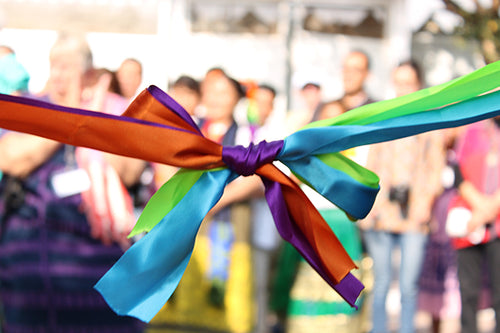
Neftali Ayungua Suárez (? - 2021) y José Neftali (Tali) Ramírez Ayungua, Patamban, Michoacán
Like many people, when you see a pineapple pot made by Neftalí Ayungua Suárez, you may say to yourself, "How does he do that?" The scaly texture perfectly simulates the surface of a pineapple which is what makes this pottery famous both in Mexico and elsewhere in the world. Everyone is impressed with their delicacy and the immeasurable amount of work required to create them. Neftalí is a true Mexican folk art legend and is featured artist in the beautiful "Great Masters of Mexican Folkart" book.
Neftalí learned his handicraft from his wife, Ana María Cuevas, and his son, (José Neftali) Tali, is now following in his footsteps. They make pots in dark green with decorative elements in light greens and white, as well as burnished red, with the detailing in black, red and white. Neftali senior is famous for his monumental towers of casseroles, one inside the other, from which he hangs diminutive cups and ladles. Neftalí has participated in over 79 competitions and walked away with a significant number of special awards and honorable mentions.
Tali uses clay, molds of baked clay and plaster that he fabricates himself, an open brick kiln, diverse burnishing tools such as smooth stones and pieces of cloth or leather, and a glazing pitch with oxides containing lead and copper. The clay (which looks more like rocks) is extracted from nearby mines, work that must be undertaken before the rainy season as some of the mines are very deep. The material is transported on the backs of mules or burros. At home, he spreads out the clay in his courtyard, breaks it up with shovels and then grinds it into a powder using a hand mill. After sifting it thoroughly, he mixes the powder with some water and then covers the material with plastic to protect it from the air. Later, he takes out what he needs for the piece he will be working on, wets the clay again to make it more malleable, and then begins the molding process.
With the pot now ready, one by one he begins to patiently add the "scales" that form the "skin" of his pineapples, covering the object completely, with symmetry and harmony. Now the pineapple is ready for its first firing. Afterward, it is left inside the kiln to cool before the glazing process begins using a preparation called greta. If the "scales" are quite small, he utilizes brushes to cover them completely.
The second firing is more delicate in that if the pieces should touch each other they would be ruined. As such, they are separated by bricks, broken pottery or whatever is at hand. The temperature for this firing is about 900 degrees Centigrade.
Madero 21
Patamban, Michoacán
351 193 8486 WhatsApp
joseayungua@hotmail.com
Facebook: taliayungua

